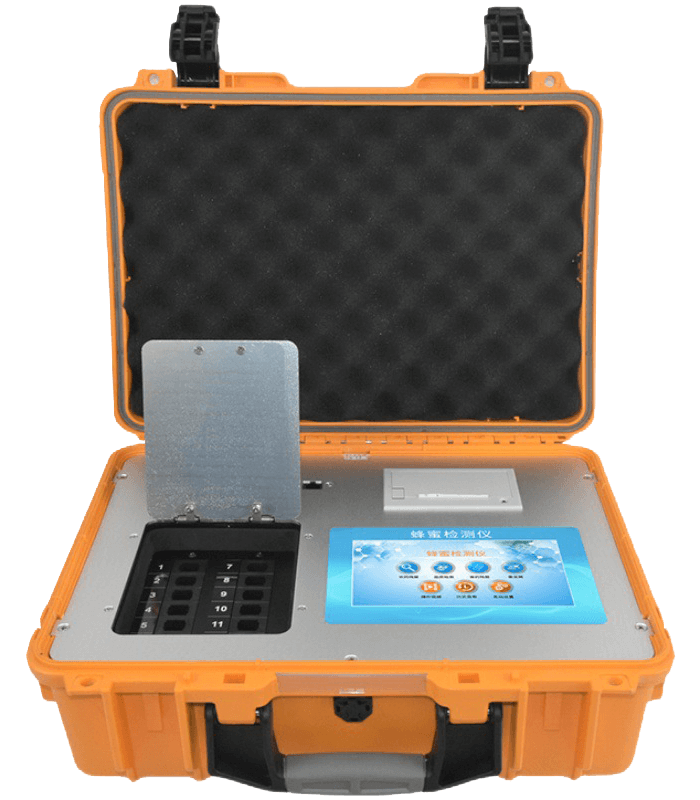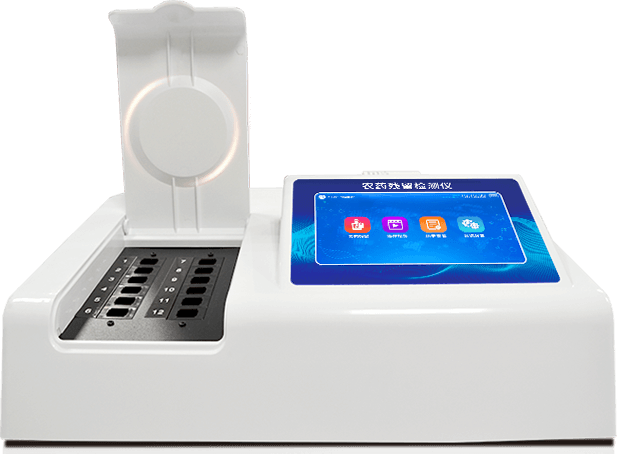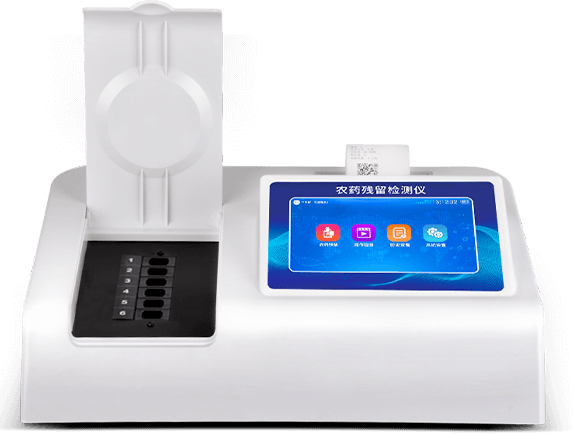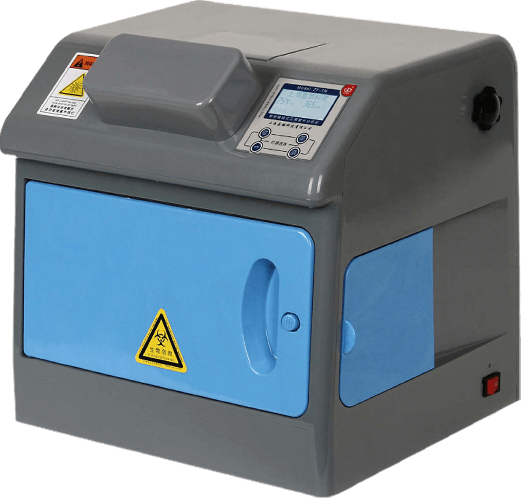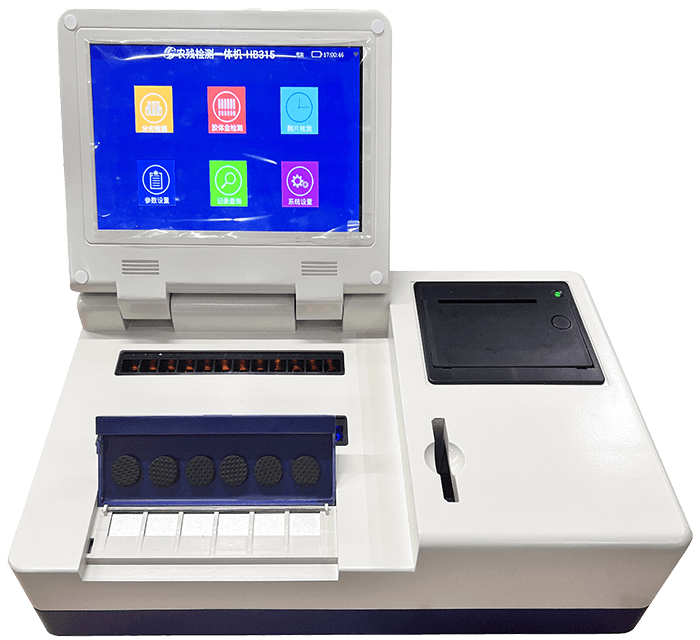
Full-featured food safety detector
- Product Number:LD-QS600
- Product Difference:One machine for multiple uses, capable of detecting pesticide residues, heavy metals, additives, and other food safety indicators
Product Introduction
The full-featured food safety testing instrument is mainly used to detect toxic and harmful substances such as pesticide residues, veterinary drug residues, and illegal additives in food. It includes a pesticide residue spectrophotometric detection module, an intelligent rapid detection module for pesticide residues using enzyme strips, a detection module for illegal additives in food, and a colloidal gold immunoassay detection module for pesticide and veterinary drug residues.
Product Features
Smart Operating System: Equipped with the Android smart system, supporting multitasking and smooth operation.
Features a quad-core high-efficiency processor, ensuring rapid response and real-time processing of detection data.
High-definition large-screen display: 10.1-inch full-view touchscreen with an intuitive and clear interface for more convenient operation.
Extended battery life: Large-capacity lithium-ion battery, capable of continuous operation for hours, meeting all-day detection requirements.
Instant report output: Built-in high-speed thermal printer, prints results immediately upon completion of detection.
Efficient data transmission: Supports WiFi wireless transmission, USB drive output, and is equipped with a USB interface.
Massive data storage: High-speed, high-capacity storage capable of storing tens of thousands of testing data points, with support for quick retrieval and export.
Multi-functional testing capabilities: A versatile device capable of testing for pesticide residues, heavy metals, additives, and other food safety indicators.
Product parameters
| Spectrophotometric Detection Module | ▲Detection Capabilities | Can detect residues of organophosphorus and carbamate pesticides, illegal additives, and other substances detectable by spectrophotometry. Proof materials such as images must be provided |
| Detection Standards | National Standard (GB/T5009.199-2003) | |
| ▲Detection Wavelengths | 410, 460, 520, 550, 590, 630 nm. Proof materials such as images must be provided. | |
| Wavelength Accuracy | ±0.2 nm (at 25°C) | |
| Transmittance | Accuracy ≤ ±0.5% (T), Repeatability ≤ ±0.5% | |
| Stray light | ≤0.01% (T) (360 nm @ 25°C) | |
| Photometric range | 0 to 4 A | |
| Absorbance resolution | 0.001 | |
| Photometric accuracy | ±0.002 (0 to 0.5 A), ±0.004 (0.5 to 1 A), ±0.3% (0 to 100% (T)) | |
| Baseline drift (optical drift) | ±0.001/h (410 nm at 25°C) | |
| Heating temperature range | 25 to 40°C | |
| Test duration | 3 minutes, with automatic timing, calculation of results, and voice prompt indicating test completion | |
| Result reading | Automatic calculation of inhibition rate and determination of positive/negative results | |
| Test channels | 24 channels | |
| Control | Default use of 1 channel as control, users can also manually select and modify to use other channels as controls | |
| Testing | Supports simultaneous testing of all 24 channels or selection of specific channels for testing | |
| Sample information | Supports convenient hierarchical menu selection of sample names, and provides quick selection options for sample source, testing unit, etc. | |
| Help | Provides video help with operating instructions | |
| Upload | Supports uploading results to the server | |
| Colloidal Gold Immunoassay Module | ▲Supported Card Types | Supports single-card, three-card, six-card, and twelve-card testing kits, with results available in one go |
| Sample Information | Supports quick selection of testing items (more items can be added in parameter settings), enter sample number (optional), select sample name, sample source, user information, etc. | |
| Test Results | Automatically calculates T-value, C-value, calculates T/C ratio, and automatically determines positive/negative results | |
| Supports direct printing of test results via the built-in printer, as well as printing of compliance certificates, which require submission of supporting documents such as images | ||
| Upload | Supports uploading test results to the server | |
| ▲Six compatible pesticide residues | Thiamethoxam, Chlorothalonil, Benomyl, Carbofuran, Thiabendazole, Imidacloprid, Detection Sensitivity Detection sensitivity: ①Thiamethoxam: 0.01 mg/kg, ②Chlorothalonil: 1 mg/kg, ③Benomyl: 0.5 mg/kg, ④ Carbofuran: 0.02 mg/kg, ⑤Thiabendazole: 0.2 mg/kg, ⑥Imidacloprid: 0.1 mg/kg When testing samples, only one pretreatment is required to simultaneously detect six pesticide residues: Thiamethoxam, Chlorothalonil, Benomyl, Carbofuran, Thiabendazole, and Imidacloprid. Proof materials such as images must be provided. | |
| ▲Can be matched with twelve pesticide residues | Carbofuran, Methidathion, Triazophos, Diazinon, Fipronil, Cypermethrin, benomyl, avermectin, thiabendazole, pyraclostrobin, cypermethrin, and chlorantraniliprole Testing sensitivity: ① carbofuran: 0.005–0.01 mg/kg, ② methomyl: 0.2–0.4 mg/kg, ③ Triazophos: 0.1–0.2 mg/kg, ④ Methamidophos: 0.1–0.2 mg/kg, ⑤ Fipronil: 0.02–0.04 mg/kg, ⑥ Cypermethrin: 5–10 mg/kg, ⑦ Benomyl: 1–2 mg/kg, ⑧Avermectin: 0.05–0.1 mg/kg, ⑨Thiabendazole: 0.05–0.1 mg/kg, ⑩Pyraclostrobin: 0.2–0.4 mg/kg, ⑪Pyriproxyfen: 0.25–0.5 mg/kg, ⑫Chlorantraniliprole: 0.01–0.02 mg/kg When testing samples, only one pretreatment is required to simultaneously detect thiamethoxam, chlorpyrifos, methoxyfenozide, triazophos, diazinon, fipronil, cypermethrin, chlorothalonil, avermectin, thiabendazole, pyraclostrobin, methoxyfenozide, and chlorantraniliprole. Proof materials such as images must be provided. | |
| ▲The test card is printed with a QR code | The QR code can be used to trace product batches, product types, manufacturers, and other information. Proof materials such as images must be provided | |
| Pesticide residue enzyme tablet rapid testing module | Standard | Complies with national standard GB/T5009.199-2003, using rapid test cards for detection. According to national standard requirements, red tablets and white tablets are stacked to react, thereby determining whether pesticide residues exceed the limit |
| Channels | Capable of simultaneously testing 6 channels | |
| Reaction time | 10-minute automatic timing, with an audio alert when the time is up | |
| Color development time | 3 minutes, with automatic timing, and an audio alert when the time is up | |
| Testing items | Pesticide residues (organophosphorus/carbamate) | |
| Sample Information | Supports input of sample ID, selection of sample name by grade, selection of sample source, and selection of user information, etc. | |
| Save | Saves test results to internal memory, allowing access to historical data via the query interface | |
| The built-in thermal printer supports printing of routine test result information and compliance certificates. After printing, the paper is automatically cut, eliminating the need for manual tearing. Proof materials such as images must be provided. | ||
| ▲Temperature control | The instrument features automatic heating and temperature control. The screen monitors temperature changes throughout the process and provides a voice prompt when the temperature reaches the appropriate 38°C (at which point the enzyme strip's temperature is closer to 37°C). Temperature control is maintained at 38°C ± 0.5°C. Proof materials such as images must be provided. | |
| Upload | Supports uploading results to the server. Proof materials such as images must be provided. | |
| Illegal Additive Detection Module | ▲Detection Capability | Can detect illegal additives in food and other substances detectable by spectrophotometry, with supporting evidence such as images required |
| Detection Standards | National Standard (GB/T5009.199-2003) | |
| ▲Detection Wavelengths | 410, 460, 520, 550, 590, 630 nm. Proof materials such as images must be provided. | |
| Wavelength Accuracy | ±0.2 nm (at 25°C) | |
| Transmittance Ratio | Accuracy ≤ ±0.5% (T), Repeatability ≤ ±0.5% | |
| Stray light | ≤0.01% (T) (360 nm @ 25°C) | |
| Photometric range | 0 to 4 A | |
| Absorbance resolution | 0.001 | |
| Photometric accuracy | ±0.002 (0 to 0.5 A), ±0.004 (0.5 to 1 A), ±0.3% (0 to 100% (T)) | |
| Baseline drift (optical drift) | ±0.001/h (410 nm at 25°C) | |
| Heating temperature range | 25 to 40°C | |
| Test duration | 3 minutes, with automatic timing, calculation of results, and voice prompt indicating test completion | |
| Result reading | Automatic calculation of inhibition rate and determination of positive/negative results | |
| Test channels | 24 channels | |
| Control | Default use of 1 channel as control, users can also manually select and modify to use other channels as controls | |
| Testing | Supports simultaneous testing of all 24 channels or selection of specific channels for testing | |
| Sample information | Supports convenient hierarchical menu selection of sample names, and provides quick selection options for sample source, testing unit, etc. | |
| Help | Provides video help with operation instructions | |
| Upload | Supports uploading results to the server |

 +86 19353291814
+86 19353291814
 +86 19353291814
+86 19353291814